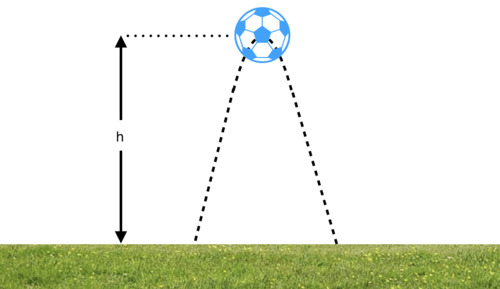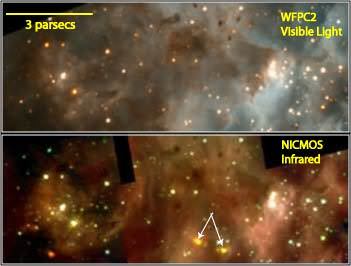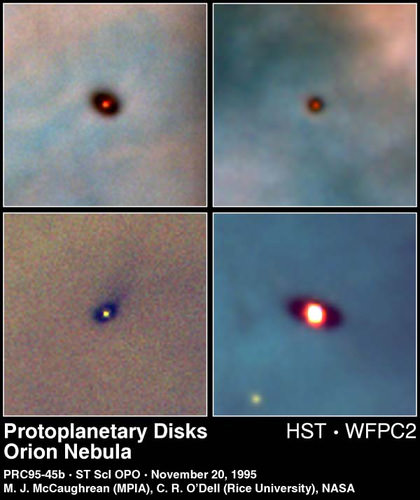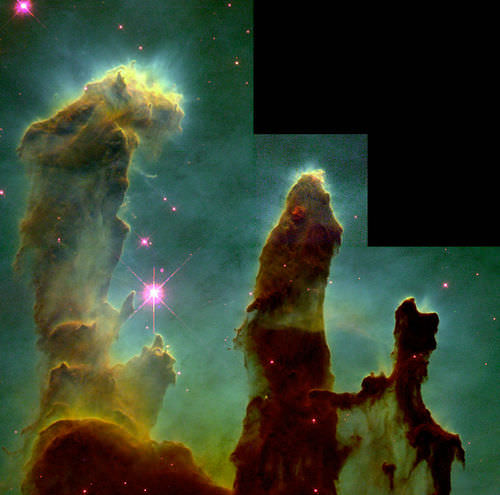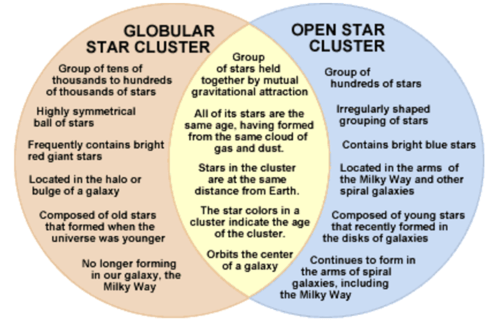4.1 恒星形成
章节大纲
-
Background: the law of gravity
::背景:重力法The story of star formation begins with gravity. Aristotle believed that the movement of objects depends on their nature (earth, water, air, fire) and their intrinsic gravitas (heaviness). M ore than a millennium passed before Galileo and then Isaac Newton improved the physical description of gravity. In 1687, Newton published his Universal Law of Gravity, a predictive and mathematical description of gravitational forces that appears in most physics textbooks:
::恒星形成的故事始于重力。 亚里士多德认为物体的移动取决于其性质(地球、水、空气、火)及其内在重力(重力 ) 。 伽利略之前已经过了一千年,然后艾萨克·牛顿改进了重力的物理描述。 1687年,牛顿发表了他的《万国引力法 》 ( Universal Law of Gravity),这是大多数物理教科书中出现的引力的预测和数学描述:[Eqn 1]
::F=GMmd2 [Eqn 1]This equation tells us that the gravitational force is proportional to the mass M of the attracting body and inversely proportional to the square of the distance between the attracting body and a particle with mass m . Double the mass, M , and the gravitational force is doubled. Double the distance, d , and the gravitational force drops by a factor of four.
::这个方程式告诉我们,引力与吸引体的质量M成比例,与吸引体与有质量的粒子之间的距离平方成反比例。 将质量、 M 和引力增加一倍。 距离、 d 加倍, 引力下降四倍。Consider the example of a ball tossed into the air in the below. In this example, the ball is at a maximum height and is just about to reverse it's upward trajectory before falling back to the Earth. The gravitational force is between the Earth with mass and the ball with mass m. The distance used in Eqn 1 must be calculated between the center of the Earth and the height of the ball: The gravitational force between the Earth and the ball is:
::以下面的球向空中抛入球的例子为例。 在这个例子中, 球处于最高高度, 在返回地球之前, 球正准备逆向向向向返回地球。 引力介于质量 M 和质量 m 的球之间。 在 Eqn 1 中使用的距离必须计算在地球中心与球高度之间的距离 : d= (Rh) 。 地球与球之间的引力是 :
::重力=GMmball(Rh)2At every point in it's trajectory, the ball has gravitational potential energy. That potential energy can do work, increasing the velocity (the kinetic energy) of the ball as it falls back toward the Earth. Because the ball stops at the surface of the Earth, the gravitational potential energy is relative to the Earth surface and proportional to the height of the ball relative to the surface of the Earth: .
::球在轨迹的每一点都具有引力潜在能量。 潜在的能量可以发挥作用, 提高球返回地球的速度( 动能) 。 因为球停留在地球表面, 引力潜在能量与地球表面相对, 与球与地球表面相对的高度成正比: U=mgh。A ball with mass, m, is tossed to a height, h. What is the gravitational force on the ball? What is the potential energy of the ball? Does the gravitational force increase or decrease with height above the Earth?
::质量为 m 的球被抛到一个高度, h. 球的引力是什么? 球的潜在能量是什么? 引力是随着地球的高度升高而增加还是减少?Gravity and General Relativity
::重力和一般相对论In 1915, Einstein published his General Theory of Relativity, treating gravity as a warping of the space-time continuum and an attribute of mass rather than a fundamental force. Einstein's description of gravity employs mathematically sophisticated metric tensors, while Newtonian gravity uses more commonly accessible algebra or calculus . O n the scales that humans are accustomed to working with (and certainly for the physics included in this course), general relativity converges to the Newtonian description, so we are justified in defaulting to the Newtonian description of gravity.Star Formation
::星形形成Spiral galaxies like the Milky Way contain about 1000 giant molecular clouds (GMCs), all located in the mid-plane of the galaxy. The GMCs are among the largest objects in galaxies with physical dimensions spanning 3 - 300 parsecs. It takes about 100 million years for the GMCs to dissipate. GMCs accumulate a mass that is roughly 100,000 times the mass of the Sun and are produced when aging stars shed their outer layers as red giants or supernovae. GMCs are comprised of hydrogen (mostly H 2 , hence the "molecular" cloud), helium and other gases as well as dust particles. Ultimately, this concentration of gas and dust collapses to form hundreds of thousands new stars and planets.
::银河等螺旋星系包含大约1000个巨型分子云(GMCs),这些云都位于星系的中空。GMCs是星系中最大的物体,物理维度为3-300个剖面。GMCs需要大约1亿年才能消散。GMCs积累了约10万倍于太阳质量的质量,当恒星作为红巨星或超新星从外层脱落出来时就会产生。GMCs由氢(主要是H2,因此是“分子”云)、氦和其他气体以及尘粒组成。最终,这种气体和尘埃的浓度会形成成千千万个新的恒星和行星。At first, the density of the GMC is low and the gravitational force is not strong enough to overcome the random thermal motion of molecules. It is likely that a shock wave - perhaps from the evolution of a nearby stars - compresses gas locally in the GMC. If the compressed regions reach a critical density, then gravity takes over . Look at Eqn (1) to understand why this is a runaway process: collapse means that the mean distance between particles is decreasing and this (decreasing d ) results in an increase in the gravitational force. Increasing the gravitational force increases the collapse, which further increases the strength of the gravitational force, and so on.
::起初, GMC 的密度很低, 引力不够强, 不足以克服分子随机热动。 很可能是冲击波 — — 可能是附近恒星的演进造成的 — — 压缩了当地GMC的气体。 如果压缩区域达到临界密度, 则重力将接管。 看看 Eqn (1) , 以了解为什么这是一个失控的过程: 崩溃意味着粒子之间的平均距离正在缩小, 而这( 下降 d ) 导致引力增加。 增加引力会增加崩溃, 从而进一步增加引力的强度, 等等 。The collapse of a critically dense region in the GMC does not produce a single star. Instead, the gas cloud fragments and smaller, denser clouds begin to collapse to form thousands of stars. Initially, the cloud is transparent to radiation, and the gravitational collapse proceeds quickly. As the cloud fragment contracts, the density and the collision rate between particles increase so that the core of the cloud begins to heat up. Gravitational potential energy is doing work at this stage, and some of the gravitational potential energy is emitted as infrared energy . As the density of the core is increasing, it becomes more opaque, trapping thermal energy in the core. At this point, the core of the cloud is a protostar with a temperature of a few thousand degrees, embedded in an obscuring shroud of cooler gas. of a star-forming region at visible and infrared wavelengths show different features . The infrared wavelengths of light penetrate the cooler gas and dust, allowing us to see the embedded protostars.
::GMC 中一个非常稠密区域的崩溃并不产生单一恒星。 相反, 气云碎片和较小、 密度更大的云开始崩溃, 形成数千颗恒星。 起初, 云对辐射是透明的, 引力崩溃很快发生。 随着云块的收缩, 粒子之间的密度和碰撞率增加, 以至于云芯的核心开始发热。 引力潜在能量在这个阶段正在起作用, 一些引力潜在能量作为红外能被排放出来。 随着核心的密度增加, 它变得更加不透明, 在核心中捕捉热能。 在这一点上, 云的核心是一颗有数千度温度的原星, 嵌在可见和红外波长的恒星成形区域, 显示不同的特点。 红外线光波长的光波长穿透了冷气和尘, 使我们能够看到嵌入的恒星。The star-forming region 30 Dor is shown in a visible light image (top) and an infrared image (bottom). Arrows in the bottom image indicate the location of two bright protostars. Why can't the protostars be seen in in the visible light image?
::恒星形成区 30 度显示在可见光图像( 上方) 和红外图像( 下方) 中。 底部图像中的箭头显示两个明亮原星的位置 。 为什么不能在可见光图像中看到原星 ?Star formation is a very inefficient process. Giant molecular clouds can churn out thousands of stars, but only a small fraction of the cloud (less than 10%) ends up in these stars. Once the stars form, the gas and dust is cleared out and, on timescales of tens of millions of years, gravitational interactions begin to kick stars out of the cluster -- the cluster begins to dissipate.
::恒星形成的过程效率非常低。巨型分子云可以将数千颗恒星排出,但只有一小部分云(不到10%)最终会进入这些恒星。一旦恒星形成,气体和尘埃就会被清除,在数千万年的时标上,引力相互作用开始将恒星从星团中踢出 -- -- 星团开始消散。When a protostar is contracting, there are two physical forces at work: gravity, which tries to collapse the protostar, and the kinetic energy of colliding particles, which resists contraction. Initially , gravity wins this battle. The protostar continues to contract and the density, temperature, and pressure in the core continue to build. As the star contracts, angular momentum is conserved and the star spins up. Kinetic energy is released as increasingly strong polar winds and turbulence in the plasma of the protostar spawn magnetic fields. Young in the Orion nebula are shown below . These objects are beginning to clear the dark cloud of gas and dus,t and the infrared light of the star, which is beginning to burn deuterium, shines through.
::当一个原生星萎缩时,有两种实际作用力在起作用:重力,它试图使原生星崩溃,和碰撞粒子的动能,它们抵制收缩。最初,重力赢得了这场战斗。原生星继续收缩,核心的密度、温度和压力在继续增加。随着恒星的收缩,角动力得到保持,恒星旋转。动能随着原生星产磁场等离子体中越来越强的极风和波动而释放出来。Orion星星云中的年轻部分显示在下面。这些物体正在开始清除气体和杜斯的阴云和恒星的红外光,开始燃烧。Protoplanetary disks around young stars in the Orion Nebula. Why are there dark rings around these bright protostars?
::猎户座星云中年轻恒星周围的原生行星磁盘。 为什么这些明亮的原始星周围有暗环?When the temperature in the core of the protostar climbs to 10 million K, the inward pressure overcomes electrostatic repulsion between the hydrogen nuclei (protons) and hydrogen fuses to form helium. With the onset of hydrogen fusion, the protostar becomes a bonafide star. The rate of hydrogen fusion continues to increase until the core generates enough energy to stabilize the gravitational collapse. If the star expands too much, then the gravitational pressure decreases, and hydrogen fusion rate slows down a bit. This self-regulating process acts like a thermostat to keep the star in balance. When the amount of energy that is being produced by hydrogen fusion is equal and opposite to the gravitational potential energy of the star, we say that the star is in hydrostatic equilibrium. These are the two defining characteristics of this "main sequence" star: hydrogen fusion in the core and hydrostatic equilibrium between the energy production from fusion reactions and gravity .
::当质子恒星核心的温度攀升到1000万K时,内向压力将克服氢核(质子)和氢引信之间的静电回退以形成氦。随着氢聚变的开始,质子恒成为正流星。氢聚变的速度将继续上升,直到核心产生足够的能量来稳定引力崩溃。如果恒星膨胀过大,引力压力就会下降,氢聚变速度会放慢一点。这种自我调节过程就像恒温器一样,使恒星保持平衡。当氢聚变产生的能量数量与恒星的引力潜能值相等,我们说恒星处于静水平衡状态。这是这个“主要序列”恒星的两个决定性特征:核心的氢聚变和来自聚变反应和重力的能量生产之间的静水平衡。The role of massive stars in star-forming regions
::巨星在恒星形成区域的作用The mass of the star determines its future evolution. More massive protostars collapse more quickly. Gravity is running the star formation show, and as the mass increases, the gravitational force increases. More massive stars contain more hydrogen, but the rate of hydrogen fusion (also called "hydrogen burning") is so much faster in high mass stars that they have much shorter lifetimes.
::恒星的质量决定了恒星的未来进化。 更大规模原星的崩溃速度更快。 重力正在运行恒星的形成展示,随着质量的上升,引力也随之增加。 更多大型恒星含有更多的氢,但高质恒星的氢聚变速度(也称“氢燃烧 ”) 则要快得多, 以至于它们的寿命要短得多。At the end of the life cycle of a star, nuclear fusion can no longer support the star against gravity. The star begins to collapse. As the outermost layers of the star fall in, they bounce off a dense wall of imploding material, and the heavy elements inside the star are expelled, enriching the interstellar medium. Stars that are about the mass of the Sun will puff off a shell of material into a nebula containing atomic elements from hydrogen up to iron. This material is eventually swept up into molecular clouds and incorporated in the next generation of star formation. The subsequent generation of stars inherits a larger fraction of heavy elements that allows them to build planets and living organisms. Stars that are significantly more massive than the Sun have a more violent ending in a supernova explosion.
::在恒星寿命周期结束时,核聚变无法再支持恒星对抗引力。 恒星开始崩溃。 随着恒星最外层的坠落, 恒星内部的重元素会从密集的喷发墙上反弹, 从而丰富星际介质。 接近太阳质量的恒星会从一个外壳上喷出一个包含从氢到铁的原子元素的星云。 这种材料最终会被冲入分子云中, 并融入下一代恒星的形成中。 后一代恒星会继承更多的重元素, 从而形成行星和活生物体。 比太阳大得多的恒星会在超新星爆炸中以更暴力的方式结束。Images of the star-forming region in the Serpens constellation show spectacular dust structures called "the ." New stars are being formed inside these structures. However, there are some rare stars that are about 80 times the mass of the Sun, and the giant molecular dust cloud is being by the high energy radiation of these stars.
::Serpens星座中的恒星成形区域图像显示惊人的尘埃结构,称为“The ” 。在这些结构中,正在形成新的恒星。然而,有些稀有的恒星大约是太阳质量的80倍,而巨大的分子尘云是由这些恒星的高能量辐射造成的。The dust clouds in this star-forming region have been named the "Pillars of Creation." These dust clouds are interstellar nurseries that are filled with low mass protostars. Why do the pillars of dust have such strange morphology?
::星系成形区域的尘云被命名为“创造的支柱 ” 。 这些尘云是星际苗圃,充满了低质量原星。 为什么尘石的柱子有如此奇怪的形态?Can you hear me now?
::你现在能听到我说话了吗?The velocity of dust in the surface of the pillars has been measured and indicates that these structures are experiencing significant mass loss. The shapes we see in the image above would have changed significantly in the 7000 years that it has taken their light to travel to us. Indeed, it is very likely that one of the massive stars in the region has already "gone supernova" and blown the pillars away completely. However, it will take many years before we get an update that revises our picture.
::已经测量了柱子表面的尘埃速度,并表明这些结构正经历着巨大的质量损失。 以上图像中我们看到的形状在7000年的时间里将会发生重大变化。 事实上,该地区一个巨型恒星已经“ 废弃超新星” , 并完全炸掉了这些柱子。 然而,我们需要许多年时间才能得到更新,才能改变我们的形象。Spiral arms and young stars
::螺旋臂和年轻恒星It is interesting to map out the location of star formation. Stars are distributed nearly uniformly in the disks of spiral galaxies, but you would never know it looking at the composite image of the . The bright spiral arms are regions of enhanced density where new star formation is triggered. Because the massive stars are the most luminous, they light up the arms during their relatively short lives and are never seen far from the molecular clouds. The youngest stars are born in clusters located along the spiral arms of the galaxy and the giant molecular clouds are seen as dark dust lanes along the trailing edge of the spiral arms. The spiral density waves that cause turbulence and large scale coherent structure are observed only in flattened galaxies but the forcing mechanism that causes the spiral density waves is complicated and still controversial.
::绘制恒星形成地点是很有趣的。 恒星几乎在螺旋星系的圆盘上分布一致, 但你永远不会知道它看的是螺旋星系的复合图像。 亮螺旋臂是触发新恒星形成时密度升高的区域。 因为巨型恒星是最亮的, 它们在其寿命较短的时间内点亮了手臂, 并且从未远离分子云。 最年轻的恒星诞生于星系螺旋臂周围的星团中, 巨型分子云被视为螺旋臂尾端的暗尘道。 导致动荡和大规模连贯结构的螺旋密度波只在平坦的星系中观测到, 但造成螺旋密度波的强制机制是复杂和有争议的。The Whirlpool Galaxy presents a view of dust lanes and massive stars tracing out spiral arms. Would you guess that there are more stars along the spiral arms? If so, you would be wrong... so what is going on? The spiral structure is a region of higher gas density, where bright, young stars are forming.
::Whirlpool银河系展示了灰尘通道和大规模恒星追踪螺旋臂的景象。 您是否猜想螺旋臂上还有更多的恒星? 如果是这样的话, 您错了... 那么到底发生了什么? 螺旋结构是一个气体密度较高的区域, 年轻恒星正在形成。Star Formation in Open Clusters
::开放聚群中的星形形成Recall that open clusters are fundamentally different from globular clusters. Globular clusters are among the oldest objects in the Milky Way galaxy and are distributed in a spherical volume above and below the galactic plane. Open clusters are concentrated in the thin disk of our galaxy. They consist of a group of hundreds of stars (compared to many thousands of stars in globular clusters). Because open clusters are smaller, they are not as tightly bound by gravity and they tend to have an irregular morphology. Open clusters are the product of new star formation from giant molecular clouds. Because open clusters contain short-lived massive stars, the most visible stars in open clusters appear bright and blue. The most luminous stars in the old globular clusters are red giants and that stellar population lends an orange cast to the cluster.
::提醒大家,开放星团与球状星团有根本的不同。 环球星团是银河系中最古老的物体之一,分布在银河系上和下方的球体体中。 开放星团集中在银河系的薄盘中。 开放星团由数以百计的恒星组成( 与数以千计的星团组成 ) 。 由于开放星团较小, 它们没有受重力的严格约束, 并且往往有不规律的形态。 开放星团是巨型分子云形成新恒星的产物。 因为开放星团中含有短寿命的巨型恒星, 开放星团中最可见的恒星团看起来是亮蓝亮的。 古星团中最亮亮的恒星群是红巨星, 星群中闪星群是橙色岩层。Globular and open clusters are both groups of stars, but with distinct attributes. Which type of cluster is older? Which is larger?
::球状星团和开放星团都是恒星群,但具有不同的特性。哪种星团更老?哪个星团更大?The old globular cluster M80 and the young open cluster M36. Why are the stars in these two clusters different in color? What other attributes are different between the globular cluster (left) and the open cluster (right)?
::旧的球状星团 M80 和 年轻的开放星团 M36 。 为什么这两个星团中的恒星在颜色上不同? 球团( 左) 和 开放星团( 右) 之间还有什么其他属性不同 ?The collapse of molecular clouds is triggered in the leading edge of spiral arms in galaxies where the dust and gas is compressed. Young bright stars in open clusters light up the arms of spiral galaxies, like sparkling diamonds. Open clusters last for a few hundred million years. Ultimately, their stars slowly disperse because of random velocities. The Sun must have formed in an open cluster of stars, but 4.5 Gyr is a long time. All of the sibling stars of the Sun have long left the nest. In contrast, globular clusters do not disperse because of the larger self-gravity of the group .
::分子云的崩溃是在星系螺旋臂的顶端触发的, 星系的灰尘和气体被压缩。 明亮的年轻恒星在开阔的星团中照亮螺旋星系的臂, 像闪烁的钻石一样。 开阔的星团持续了数亿年。 最终, 它们的恒星由于随机的速率而慢慢散散开。 太阳一定是在开放的恒星团中形成, 但有4.5 Gyr 是很长的时间。 太阳的所有吊状恒星都早已离开了巢。 相反, 球团由于星团的较大自重力而没有散开。Best Friends Forever: Binary Stars
::永远最好的朋友:二元星Our Sun is a loner - a single star. However, roughly half of the stars in our galaxy are gravitationally bound to another star. Such stars are called "binary" stars and they can have orbital periods as short as an hour or as long as thousands of years. Remarkably, a series of papers in the 1990's showed that the fraction of binary star systems depends on the spectral type of the stars. The O and B type stars are exceedingly rare. However, roughly 75 % of these massive stars are gravitationally bound in binary star systems. In contrast, about 60% of stars like our Sun have a gravitationally-bound stellar buddy and only 40% of the smallest stars - the low mass M dwarfs - have binary stellar companions.
::我们的太阳是一个孤星,是一个单一的恒星。然而,我们星系中大约一半的恒星在引力上与另一颗恒星相连。这些恒星被称为“双星 ” , 它们的轨道周期可以短于一个小时或长达数千年。 值得注意的是,1990年代的一系列论文显示,二星系的一小部分取决于恒星的光谱类型。 O型和B型恒星非常罕见。 但是,这些巨大的恒星中,大约75%的恒星在双星系中被引力捆绑。 相比之下,像我们太阳这样的恒星中,大约60%的恒星有引力外的恒星,而最小恒星中只有40%的最小恒星—— 低质量的M矮星—— 有二星系的恒星伴。
